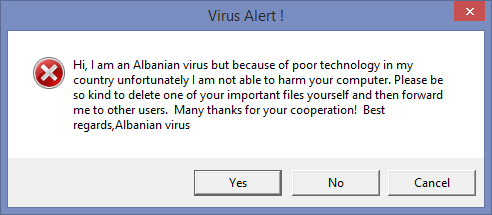When I first read about the newly discovered kind of OS X and iOS malware called XcodeGhost, quite frankly, the first thing that came to my mind was: “That’s the Albanian virus!” In case you don’t remember the original reference, here’s what it looks like:

I can vividly imagine a conversation among hackers, which would go like this:
- Why do we have to spend so much effort on planting our malware on user devices? Wouldn’t it be great if someone would do it for us?
- Ha-ha, do you mean the Albanian virus? Wait a second, I’ve got an idea!
Unfortunately, it turns out that the situation isn’t quite that funny and in fact poses a few far-reaching questions regarding the current state of iOS security.
What is XcodeGhost anyway? In short, it’s Apple’s official developer platform Xcode for creating OS X and iOS software, repackaged by yet unknown hackers to include malicious code. Any developer, who would download this installer and use it to compile an iOS app, would automatically include this code into their app, which is then submitted to the App Store and distributed to all users automatically as a usual update. According to Palo Alto Networks, which published a series of reports on XcodeGhost, this malware is able to collect information from mobile devices and send them to a command and control server. It would also try to phish for user’s credentials or steal their passwords from the clipboard.
Still, the most remarkable is that quite a few legitimate and popular iOS apps from well-known developers (mostly based in China) became infected and were successfully published in the App Store. Although it baffles me why a seasoned developer would download Xcode from a file-sharing site instead of getting it for free directly from Apple, the list of victims includes Tencent, creators of the hugely popular app WeChat that has over 600 million users. In total, around 40 apps in the App Store have been found to contain the malicious code. Update: another report by FireEye identifies over 4000 affected apps.
Unfortunately, there is practically nothing that iOS users can do at the moment to prevent this kind of attack. Surely, they should uninstall any of the apps that are known to contain this malicious code, but how many have not yet been discovered? We can also safely assume that other hackers will follow with their own implementations of this new concept or concentrate on attacking other components of the development chain.
Apple’s position on antivirus apps for iOS has been consistent for years: they are unnecessary and create a wrong impression. In fact, none of the apps remaining in the App Store under a name “Antivirus” is actually capable of detecting malware: there are no interfaces in iOS, which would allow them to function. In this regard, user’s safety is entirely in Apple’s hands. Even if they upgrade the App Store to include better malware detection in submitted apps and incorporate stronger integrity checks into Xcode, can we be sure that there will be no new outbreaks of this kind of malware? After several major security bugs like Heartbleed or Poodle in core infrastructures discovered recently (and yes, I do consider Apple Store a critical infrastructure, too), how many more times does the industry have to fall on its face to finally start thinking “security first”?
















































